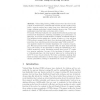Free Online Productivity Tools
i2Speak
i2Symbol
i2OCR
iTex2Img
iWeb2Print
iWeb2Shot
i2Type
iPdf2Split
iPdf2Merge
i2Bopomofo
i2Arabic
i2Style
i2Image
i2PDF
iLatex2Rtf
Sci2ools
WDAG
2009
Springer
2009
Springer
Virtual Ring Routing Trends
Virtual Ring Routing (VRR) schemes were introduced in the context of wireless ad hoc networks and Internet anycast overlays. They build a network-routing layer using ideas from distributed hash table design, utilizing randomized virtual identities along a ring. This makes maintenance practical when nodes may enter or leave. Previously, VRR was evaluated over a small wireless network and through medium-scale simulations, exhibiting remarkably good performance. In this paper, we provide a formal analysis of a family of VRR-like schemes. The analysis provides insight into a variety of issues, e.g., how well does VRR perform compared with brute force shortest paths routing? What properties of an underlying network topology make VRR work well? Our analysis is backed by extensive simulation over a variety of topologies. Whereas previous works evaluated VRR over fairly small networks (up to 200 nodes), we are interested in scaling the simulations so as to exhibit asymptotic trends. Simulating...
| Added | 25 May 2010 |
| Updated | 25 May 2010 |
| Type | Conference |
| Year | 2009 |
| Where | WDAG |
| Authors | Dahlia Malkhi, Siddhartha Sen, Kunal Talwar, Renato Fonseca F. Werneck, Udi Wieder |
Comments (0)

